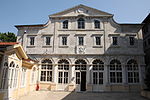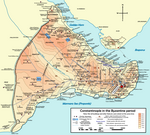Ecumenical Patriarchate of Constantinople

The Ecumenical Patriarchate of Constantinople (Greek: Οἰκουμενικὸν Πατριαρχεῖον Κωνσταντινουπόλεως, romanized: Oikoumenikón Patriarkhíon Konstantinoupóleos, IPA: [ikumeniˈkon patriarˈçion konstandinuˈpoleos]; Latin: Patriarchatus Oecumenicus Constantinopolitanus; Turkish: Rum Ortodoks Patrikhanesi, İstanbul Ekümenik Patrikhanesi, "Roman Orthodox Patriarchate, Ecumenical Patriarchate") is one of the fourteen to sixteen autocephalous churches (or "jurisdictions") that together compose the Eastern Orthodox Church. It is headed by the Ecumenical Patriarch of Constantinople, currently Bartholomew I, Archbishop of Constantinople. Because of its historical location as the capital of the former Eastern Roman (Byzantine) Empire and its role as the mother church of most modern Orthodox churches, Constantinople holds a special place of honor within Orthodoxy and serves as the seat for the Ecumenical Patriarch, who enjoys the status of primus inter pares (first among equals) among the world's Eastern Orthodox prelates and is regarded as the representative and spiritual leader of Eastern Orthodox Christians.The Ecumenical Patriarchate promotes the expansion of the Christian faith and Eastern Orthodox doctrine, and the Ecumenical Patriarchs are involved in ecumenism and interfaith dialogue, charitable work, and the defense of Orthodox Christian traditions. Prominent issues for the Ecumenical Patriarchate's policy in the 21st century include the safety of the believers in the Middle East, reconciliation of the Eastern Orthodox and Catholic churches, and the reopening of the Theological School of Halki, which was closed down by the Turkish authorities in 1971.
Excerpt from the Wikipedia article Ecumenical Patriarchate of Constantinople (License: CC BY-SA 3.0, Authors, Images).Ecumenical Patriarchate of Constantinople
Dr. Sadik Ahmet Caddesi, Istanbul
Geographical coordinates (GPS) Address Nearby Places Show on map
Geographical coordinates (GPS)
| Latitude | Longitude |
|---|---|
| N 41.029166666667 ° | E 28.951666666667 ° |
Address
Aya Georgi Katedrali
Dr. Sadik Ahmet Caddesi
34083 Istanbul
Türkiye
Open on Google Maps








